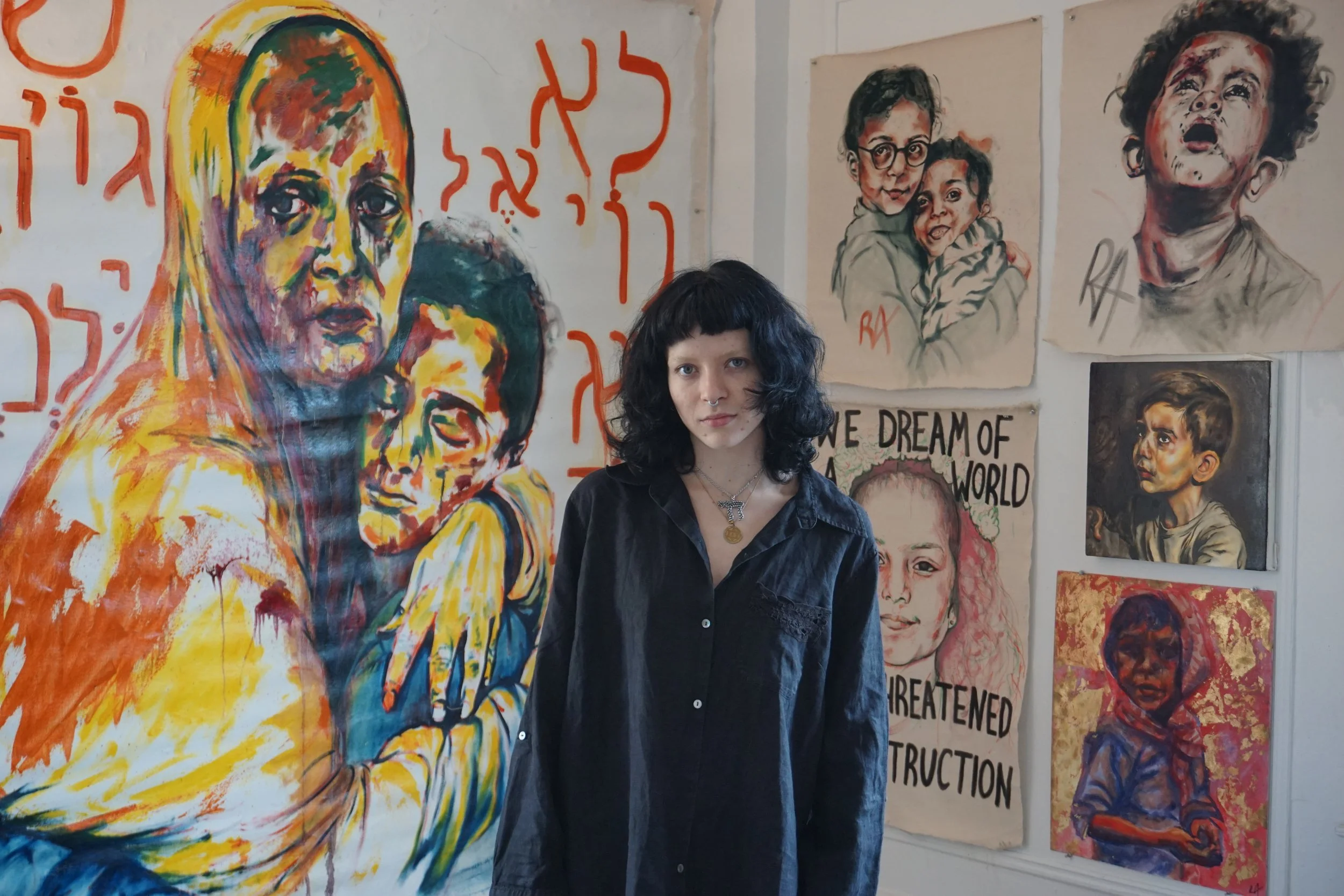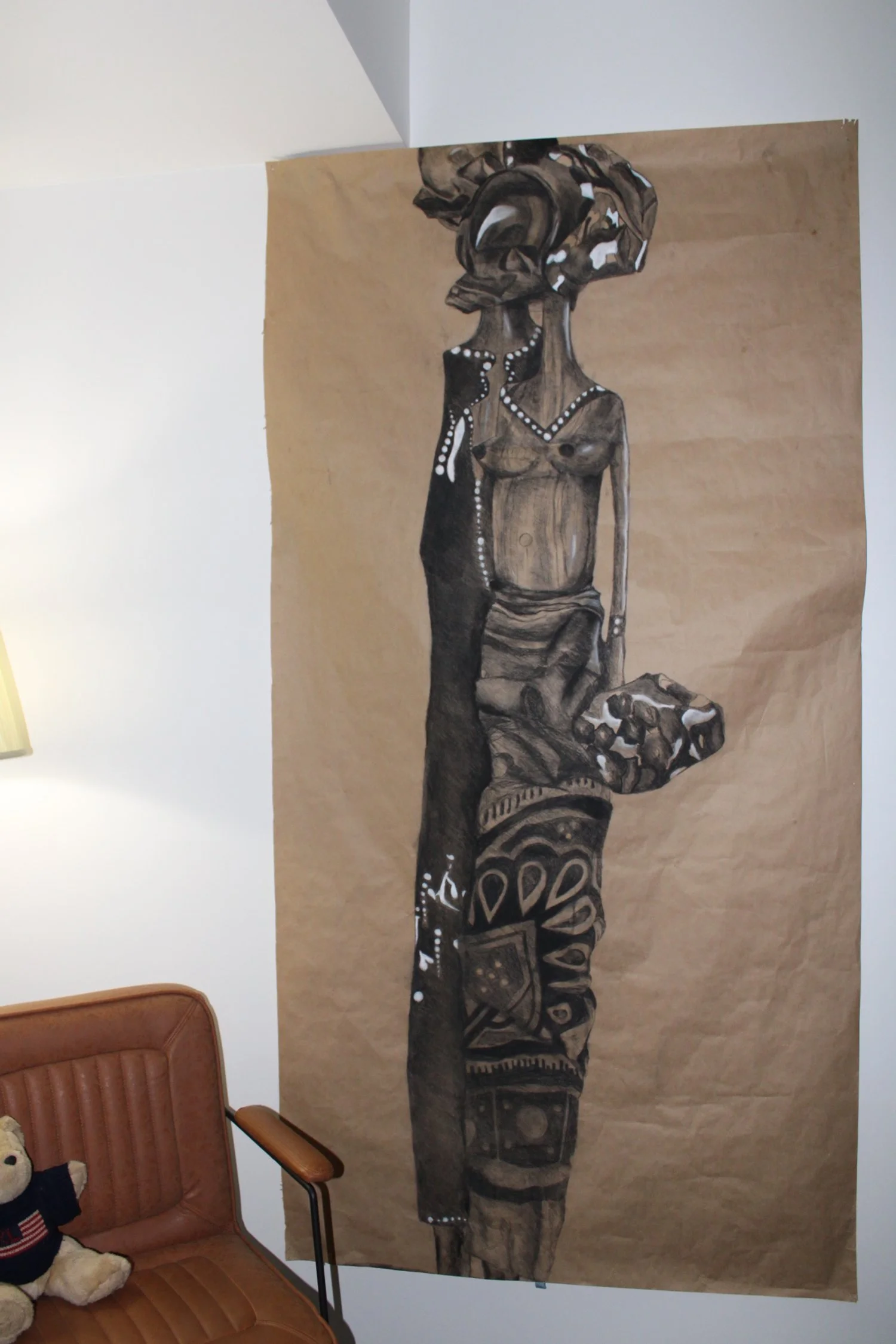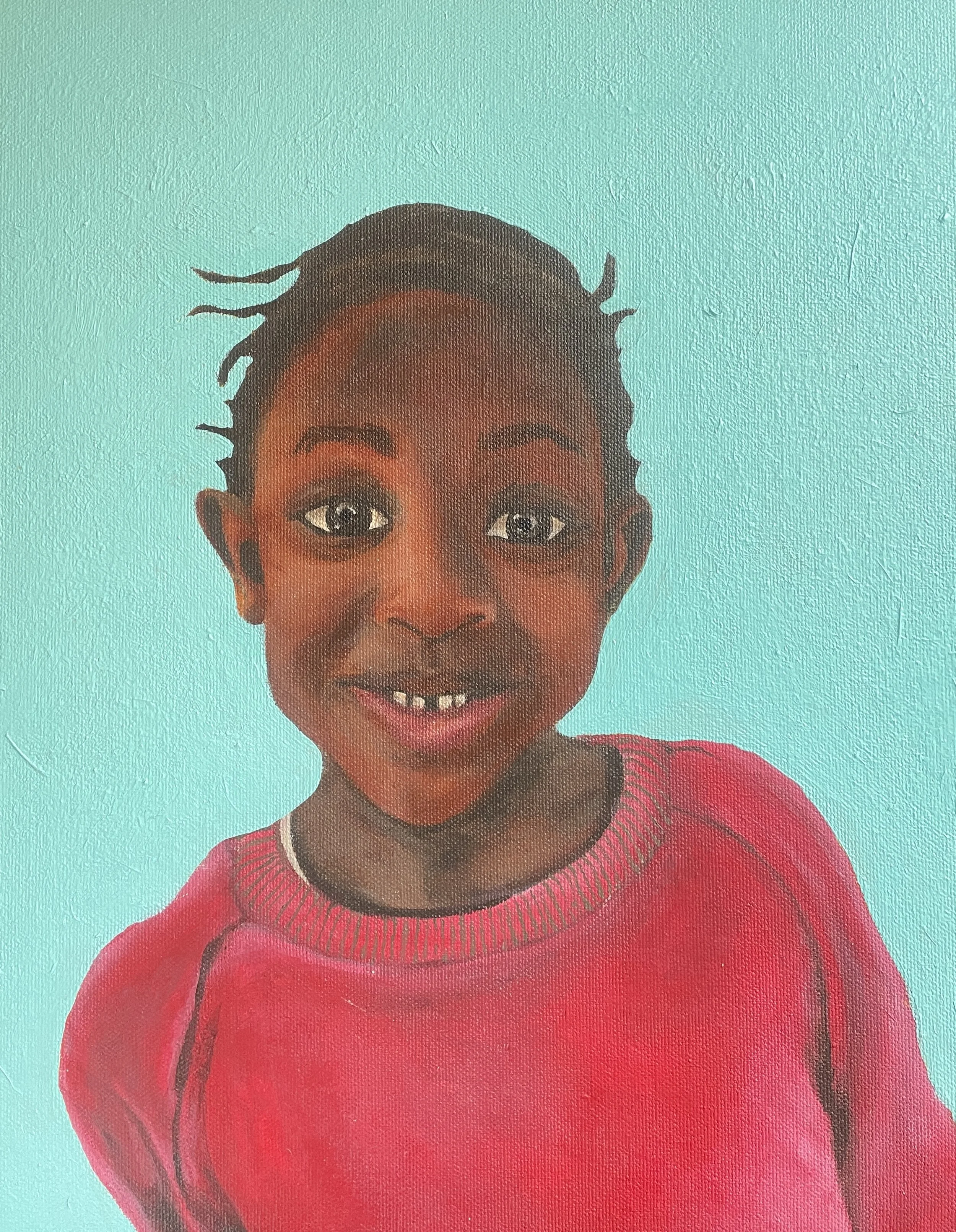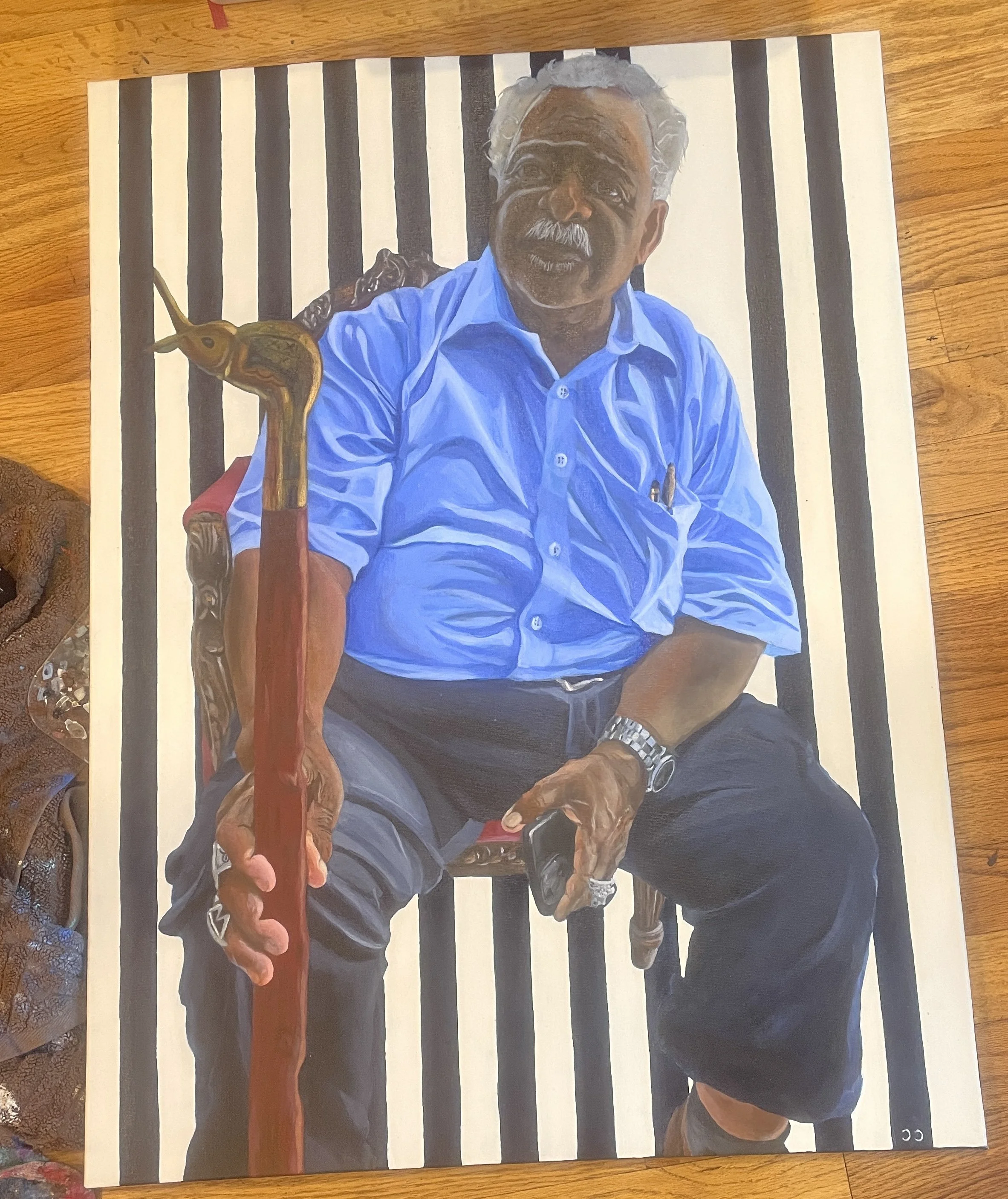Feature by Mira Krish
Photos by Iris Pope






Naa Ayorkor Laryea, or Koko, is studying Psychology at Barnard in the class of 2027. She is from Maryland and recently transferred from University of Maryland. She paints bright, detailed portraits inspired by reflection, connection, and her cultural heritage.
It is a warm Sunday evening when I meet Ayorkor at her apartment for our interview. Sinking into her couch I can see out her living room window. The setting sun paints the opposing building a golden color, the warm type of shade often used in Ayorkor’s paintings. By the end of our conversation, the sun is gone and the buildings have returned to their ordinary hue.
Upon entering her apartment, I knew only two things about Ayorkor: she is a psychology major and she paints portraits. So naturally, one of my first things I asked her was why, what connects the two? She explains to me how she sees it: psychology is the study of the mind, and portraiture is the study of people. They are, at their crux, one subject matter through different lenses. Two sides of the same coin. Ayorkor has always had a love for people—understanding them and portraying them. Laughing, she recalls asking her dad for a psychology book in fifth grade.
Ayorkor feels a sense of certainty in the idea that art and art creation is her purpose. Growing up her household was consistently saturated with art and culture, giving Ayorkor her longtime love for art. Ayorkor’s mother is a musician, and her father is a lover of African art. Ayorkor’s father has always ensured that she was aware and appreciative of her culture. Being West African, half Nigerian and half Ghanian, she tells me that in her childhood home her father is always wearing traditional clothing and cooking traditional food. As a result, Ayorkor feels deeply in tune with her heritage in her own accord; she sees it for its beauty and feels that it is often misunderstood. A lot of the time Ayorkor’s paintings are about portraying her heritage and identity in a way that she can connect to and feel proud of.
untitled 1
At the time of our interview, Ayorkor’s sister had been staying with her. The two of them had been spending time reflecting about their childhood, and she shared with me a conversation they’d been having. “Our parents genuinely surrounded us with art, and not just visual art, but music. We were always listening to music in the house. My mom would take us to jazz concerts, even on school nights. And we would just sit there with older people, and I feel like my perspective for life just developed really fast.”
Ayorkor’s portraits are bright, playful depictions of people. Her subject is usually someone she knows, if not from an online reference, and her work is an attempt to capture their aura on canvas. Her art depicts the world as she chooses to see it, it’s based on observations and intricacies that capture her attention in the everyday. She conceptualizes her portraits in series with distinct themes, a few thus far have been Remembrance, Elders, and Black professors. Though, she admits to me that it is difficult to be both a student and an artist—so far her only complete series is Remembrance. It began by painting children, like her younger cousin. “I started off with just like painting kids, because I love kids and I feel black children aren't always shown in ways that I think represent youth.” She feels that her work is her part in creating representation.
yemi
She has another series focused on the elders in her life, she has one featuring a family friend, and one about her grandfather is in the works. This series began in direct response to Remembrance. She pauses, trying to explain her inspiration to me, “I think it was about transition, again. I love transitions and adaptations. I previously painted kids, and I wanted to go the opposite, so elders. I didn't find it that different, even though obviously an older person has more wrinkles and their face looks different. But I definitely do believe you look the same, that the older you get you kind of revert back.” The proof of her belief in this sentiment is in her painting. Her portrait of her family friend catches him in a sort of youthful unburdened happiness, despite the obvious signs of his age. It makes me feel happy, she says that it makes her happy too. Her friend has been an art collector for his entire life. After years of looking at his collected paintings, she has been able to depict him in one of his own.
the collector’s edition
Another series of Ayorkor’s commemorates Black professors. She started this at her previous college, University of Maryland, and is still deciding whether it should be resumed at Barnard. Ayorkor’s work consistently depicts Black life across generations. When I asked her about why she has made this choice thus far, she told me, “To me, it's kind of like a resistance. American culture tells us white people are the center. And I find it liberating to not care about that.” Interested in this artistic constant, I then asked her if she sees herself painting Black people exclusively in her artistic future, she told me she does not. At the end of the day, it comes back to Ayorkor’s love of people: this will continue to be the driving factor in her art regardless of how it looks.
It is obvious that Ayorkor has always loved art, however, she only started painting portraiture in the 9th grade, when as she recounts, she simply felt a drive to pick up the paint brush. Telling me about how her painting process typically goes, she said, “I don't like copying things. I really like using a reference, and building from it, and kind of just developing my own style.” She will typically underpaint her canvas a shade of burnt sienna, a color that reminds her of the soil in West Africa. She sketches her reference in pencil, a practice that is frowned upon within the confines of traditional painting etiquette because the graphite marks can sometimes be seen in the finished piece. But Ayorkor doesn't care—she prefers the control that the pencil gives her.
While she loves portraiture, Ayorkor tells me she feels a shift in her style oncoming. She feels her move to New York has come with many new observations which will serve as inspiration for her new work. She already has some inkling of what this will look like. She hopes to create something about the corporate scene or perhaps something about scenes of life in New York. While she is not entirely sure of the form these ideas will take, she feels a pull towards the representational rather than the literal. She also wants to experiment with new mediums, like ceramics.
untitled 2
I was impressed with the confidence that Ayorkor possesses when it comes to creating art without any formal training. She gives herself a lot of freedom when it comes to her painting and maintains a certainty that art is her purpose. When I asked her about where her confidence stems from, she told me something her mom always tells her: "You will do what you want to do—, there are no constraints.” These words are embodied in almost every aspect of her creation, style, process, subject matter, and medium.
With that, our interview was almost over. Ayorkor told me that she is very much excited about her move to New York and the transition to Barnard, and that she has not been painting at all since she got here but hopes to start soon. When she does start, she will be painting in her room, as she always does. She has big plans for the future, while she has just started her third year she predicts that she will pursue a career in psychology. As one of my last questions I ask her if she will continue to create art she says definitely, stops for a moment and then continues, “I feel like it [art] is my purpose 100%, in the sense that it is not only one of my first loves, but it feels like what I'm drawn to do here while I'm here on this planet.”

































